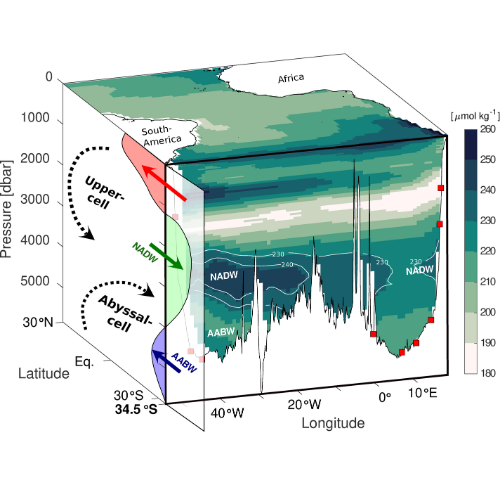First-ever daily time series of the strength of the abyssal MOC cell in the South Atlantic
The critical role played by the Meridional Overturning Circulation (MOC) in redistributing mass, heat, salt, and carbon within the global climate system is well known. MOC variations have important impacts on many planetary scale climate phenomena, including extreme weather (hurricanes, droughts, and heat waves), coastal sea level, surface air temperatures, and precipitation patterns – thereby impacting human society in many ways.

Array locations and simple schematic of water mass overturning transports. Study area with shaded colors representing oxygen concentrations (μmol kg-1) at the surface and along the 34.5°S SAMBA line from the World Ocean Atlas 2018 annual climatology. The tongues of elevated oxygen concentrations along the western and eastern boundaries identify different branches of recently ventilated NADW as it crosses 34.5°S (white contours). Locations of the nine SAMBA moorings used for computing the zonally integrated meridional geostrophic flow are represented as red squares. Conceptual schematics of the volume transport across 34.5°S and of the upper and abyssal Atlantic overturning cells are indicated on the left side of the panel. Colors indicate the classes of seawater density (red: shallow and intermediate; green: deep; blue: abyssal) (click image to enlarge).
In a recent article published in the journal Science Advances, researchers investigate the MOC flows at the southern end of the South Atlantic Ocean, which serves as the gateway for water masses formed in the Pacific, Indian, and Southern Oceans to exchange and mix with Atlantic Ocean waters. Numerical climate models suggest that flow patterns in the South Atlantic exert control on the stability of the entire global MOC system. A main goal of this study was to evaluate the variability of the oceanic circulation across 34.5°S in the South Atlantic at all depths and at a daily frequency (i.e., with very high temporal resolution).
A basin-wide array of moored oceanographic sensors at 34.5°S represented the primary data set used by the authors of this new study. The international South Atlantic MOC Basin-wide Array (SAMBA) has been designed, built, and maintained by NOAA-AOML together with scientists from partner organizations in Argentina, Brazil, France, and South Africa. SAMBA began making pilot observations in 2008-2009, and has been making continuous daily MOC measurements since September 2013.
As documented in this new study led by Dr. Marion Kersalé (University of Miami), the first ~4 years of continuous data from the SAMBA array provide remarkable insights into the full-depth vertical, horizontal, and temporal resolution of the MOC. One key new result in this paper is the first-ever daily estimation of the time-varying strength of the abyssal cell at 34.5°S (from 3000 m to the seafloor). The only previous estimates of the abyssal cell in the South Atlantic have come from once-a-decade ‘snapshot’ ship section estimates – so this new result represents a major advance. The new study also includes the longest and most accurate daily record for the upper overturning cell in the South Atlantic. This study has demonstrated that the upper-cell circulation is much more energetic than the abyssal-cell at all time scales resolved by the four-years records, and also shows that the flows in the upper and abyssal cells generally vary independently of one another.
Highly variable upper and abyssal overturning cells in the South Atlantic (Science Advances)
Topics
- Southern Ocean
- Atlantic Ocean
- AMOC
